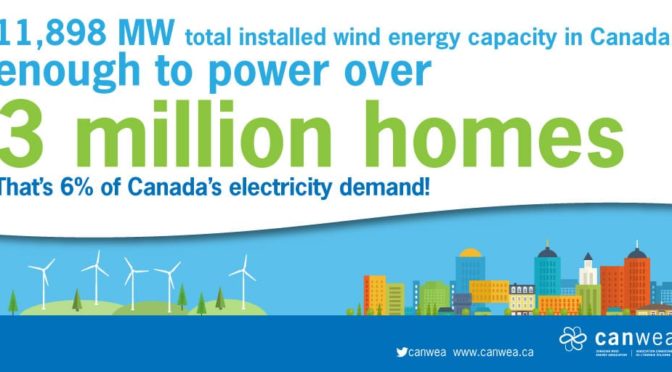Canada’s wind energy industry had another year of strong growth in 2016, adding 702 MW of new capacity through the commissioning of 21 projects in Ontario, Quebec and Nova Scotia. Sixteen of these projects are owned, at least in part, by aboriginal or local communities, or municipal governments. Canada now has 11,898 MW of installed wind generation capacity, enough to supply six percent of Canada’s electricity demand and meet the annual electricity needs of more than three million homes.
Wind energy and natural gas are the two most cost-competitive sources of new electricity generation in Canada today and wind energy has been the largest source of new electricity generation in Canada since 2005. Between 2012 and 2016, Canada’s installed wind energy capacity has grown by an average of 18 per cent, or 1,327 MW annually.
The Canadian Wind Energy Association (CanWEA) expects Canada to install approximately 700 MW of new wind energy capacity in 2017. New wind energy procurement in Alberta and Saskatchewan in 2017, coupled with a renewed focus in Canada on actions to transition to a low carbon economy, mean that wind energy’s growth prospects will remain strong in Canada for many years to come.
“More wind energy has been built in Canada in the last 11 years than any other form of electricity generation, and for good reason,” said Robert Hornung, President of CanWEA. “Costs for wind energy have fallen dramatically over the past seven years, making wind energy one of Canada’s two most cost-competitive sources of new electricity supply. And unlike natural gas, wind energy is not impacted by carbon prices or commodity price fluctuations, meaning that wind energy will only become more affordable over time. The fact that the vast majority of new wind energy projects built in Canada in 2016 had some form of local ownership demonstrates the value of wind not only as a driver of economic growth, but also as a source of local jobs and revenue in communities right across the country.”
Facts
- Ontario continued to lead Canada in market size and growth, adding 413 MW of new wind energy capacity in 2016 to bring its total installed capacity to 4,781 MW.
- Quebec added three projects totalling 249 MW of capacity in 2016, ending the year with 3,510 MW of wind energy on its grid and maintaining its position as the second largest wind energy market in Canada.
- Nova Scotia installed more wind energy projects than any other province in 2016, with 10 new facilities totalling 39.5 MW coming on line, most driven by the province’s unique community feed-in tariff program. Nova Scotia ended the year with 579 MW of wind energy capacity, placing it fourth among the provinces for total installed capacity.
- Canada’s new wind energy projects in 2016 represented about $1.5 billion in investment.
- There are now 285 wind farms made up of 6,288 wind turbines operating in Canada, bringing economic development and diversification to well over 100 rural communities through land lease income, property tax payments, ownership revenue and community benefits agreements.
- Canada’s first commercial wind facility, the Cowley Ridge Wind Farm, was decommissioned in 2016, 23 years after it began operations in southern Alberta in 1993. Alberta added no new wind capacity last year, but remains Canada’s third largest wind market with 1,479 MW.
Background
Levelized Cost of Energy Analysis 10.0, published in Nov. 2016 by the financial advisory firm Lazard, shows how the cost of wind energy has fallen 66 per cent over the past seven years in the United States.
National Energy Board statistics (appendices: electricity capacity) show more wind energy was built in Canada than any other source of electricity generation from 2005 to 2015
CanWEA’s Wind Markets webpages contain detailed information on the role of wind energy in markets across Canada.




